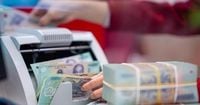From the start of 2025 through mid-year, Vietnam's banking sector has witnessed a notable trend: deposit interest rates have largely remained stable or slightly decreased, while lending rates have continued to fall, signaling a strategic move to support economic growth and business expansion amid a complex financial landscape.
According to the State Bank of Vietnam (SBV), deposit interest rates at commercial banks have been relatively steady, with minor adjustments downward at several institutions since early July. For instance, BacABank reduced its deposit rates by 0.1 percentage points across all terms and deposit types, while VIB cut rates by 0.1% per annum on 36-month deposits for amounts between 1 billion and under 5 billion VND. BaoVietBank also trimmed rates by 0.15 to 0.2 percentage points for terms spanning 6 to 13 months. Earlier in the year, LPBank lowered online deposit rates by 0.2% for 18 to 60-month terms, and NCB reduced rates by 0.1% depending on the term.
This cautious easing of deposit rates reflects a broader effort to maintain liquidity and manage financial stability. MB Securities (MBS) noted that the decline in deposit interest rates slowed in June, with only a handful of banks—LPBank, BacABank, and VPBank—adjusting rates downward by 0.1 to 0.2 percentage points across various terms. By the end of June, the average 12-month deposit rate for commercial banks had decreased by 0.17 percentage points from the start of the year, settling at 4.87% per annum, while state-owned commercial banks held steady at 4.7%.
Despite this stability, MBS analysts believe that deposit rates have not yet bottomed out and could dip further in the third quarter of 2025, buoyed by robust credit growth since April and steady or declining interbank rates. However, they also anticipate a slight uptick in deposit rates in the fourth quarter, aligning with the typical surge in credit demand toward year-end.
Indeed, the credit landscape has been dynamic. As of the end of June, total credit outstanding in Vietnam's banking system had risen by 9.9% compared to the end of 2024 and surged 19.3% year-on-year, marking the highest growth in recent years. This vigorous lending activity has put some pressure on bank liquidity, as observed by KB Securities (KBSV), which warned that liquidity could tighten at certain points, especially during the year-end credit push. KBSV does not rule out a modest increase in deposit interest rates starting in the fourth quarter of 2025 to attract more funds.
Meanwhile, Vietcombank Securities (VCBS) projects that deposit rates will remain stable, given the SBV's commitment to maintaining consistent monetary policy tools that align with macroeconomic targets. Lending rates, VCBS expects, will stay low to bolster business activity in line with government directives. However, lending rate fluctuations may vary across industries and companies, with businesses having weaker credit histories potentially facing higher borrowing costs.
On July 22, 2025, the SBV reiterated its support for preferential loan packages directed at priority sectors, emphasizing the importance of steering credit towards production, business, and growth drivers. The government’s June 2025 resolution tasked the SBV with closely monitoring both domestic and international developments, managing monetary policy tools flexibly and proactively, and harmonizing exchange rates and interest rates to reduce lending costs. The SBV was also urged to remove administrative controls over credit growth, moving towards a market-based, risk-assessed approach, with new credit safety criteria to be finalized by the end of July.
In the realm of lending, the average new loan interest rate stood at 6.23% per annum by late July, down 0.7 percentage points from the end of 2024. This decline is seen as a positive signal for businesses and individuals seeking to expand operations or purchase homes. Notably, young borrowers under 35 years old can access social housing loans at a favorable rate of 5.9% per annum, reflecting targeted policy support.
On the deposit front, digital banking platforms and some commercial banks are competing to attract medium- and long-term funds. Vietcombank's digital platform VCBNeo recently increased savings rates by 0.1 percentage points for 1 to 6-month terms, offering a top rate of 5.45% for deposits of 13 months or longer. Cake by VPBank maintains a 6% rate for 12 to 36-month terms, with loyal customers receiving an additional 0.2 percentage points, bringing the effective rate to 6.2%—the highest in the digital banking market.
Other banks are also offering competitive rates around 6% to retain mid- and long-term deposits. HDBank pays 6% for 18-month terms; Bao Viet Bank offers 6.1% for 60-month terms and 6% for 48-month terms; BacABank holds steady at 6% for 18 to 36 months. VPBank recently raised online deposit rates by 0.1 percentage points across all terms. For deposits under 3 billion VND, rates range from 3.7% per annum for 1-month terms to 5.3% for 24 to 36 months.
Yet, despite these nominal increases in short-term deposit rates (1 to 3 months), real returns remain modest, hovering between 3.4% and 3.7% per annum. This has led some individual investors to explore alternative investment channels such as corporate bonds, stocks, or real estate.
Financial expert Duong Anh Vu observes that recent interest rate hikes at some banks primarily address localized liquidity issues rather than signaling a systemic trend. He notes that interbank liquidity remains ample, making a sharp rise in deposit rates unlikely in the near term. However, he cautions that persistently low deposit rates amid exchange rate pressures could shift risks to the foreign exchange market. Although the US dollar has weakened internationally, the Vietnamese dong continues to depreciate against the USD, posing a dual challenge to the domestic currency and financial demand.
On the broader monetary front, the SBV's latest data reveal that total payment instruments reached over 18.7 million billion VND by the end of May 2025, up 4.5% from the start of the year. Deposits flowing into the banking system continue to rise despite low deposit rates, underscoring sustained confidence in the banking sector.
Meanwhile, the interbank market shows slightly declining interest rates in July 2025. On July 21, the average VND interbank rates dipped by 0.02 to 0.06 percentage points across terms under one month, with overnight and one-week rates at 5% per annum, two-week rates also at 5%, and one-month rates at 4.93%. USD interbank rates remained steady for overnight and two-week terms, with a slight 0.01 percentage point decrease for other terms, ranging between 4.3% and 4.43% per annum.
The government bond market experienced rising yields for most maturities except the 3-year term, which held steady at 2.37%. Other yields recorded were 2.67% for 5 years, 3.03% for 7 years, 3.28% for 10 years, and 3.4% for 15 years.
On the same day, the SBV conducted a bidding operation on the mortgage channel, offering 29,000 billion VND for 7, 14, and 91-day terms at a fixed 4% interest rate. The successful bids totaled 3,818.7 billion VND for 7-day terms and 16,545.63 billion VND for 14-day terms, with no transactions for the 91-day term. Concurrently, 17,160.37 billion VND matured, resulting in a net injection of 8,203.86 billion VND into the market through open market operations. At the close of trading, mortgage channel liquidity stood at 151,219.55 billion VND, while treasury bills in circulation were 1,999.9 billion VND.
Overall, Vietnam’s interest rate environment in 2025 reflects a delicate balancing act. The SBV and commercial banks are carefully managing deposit and lending rates to foster economic recovery, support credit growth, and maintain liquidity. While deposit rates hover near historically low levels, lending rates continue their downward trajectory, providing relief to borrowers and signaling an accommodative stance in monetary policy. As the year progresses, market participants and policymakers alike will watch closely for shifts tied to credit demand cycles, liquidity pressures, and external economic factors.





